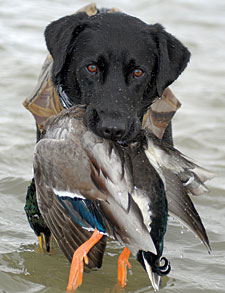 Mason, the author's Labrador, is a seasoned open-water hunter with hundreds of mallards to his credit. |
Mallards are among the most adaptable of all waterfowl. This grassland-nesting species is commonly found in city parks and adapts quickly to almost any food source or habitat niche. In areas where hunting pressure is heavy, mallards are increasingly forced to seek open water for roosting instead of their traditional marsh habitat.
A mallard in open water is a duck of a different nature. Hunting mallards in open water calls for tactics more often associated with diver ducks than puddle ducks. Getting the birds in close enough for a clean kill is doubly tough, and often retrievers are faced with "mega marks" on birds that fall a football-field-length or more away from the blind. No bigger challenge awaits any duck dog than chasing down a wounded mallard in open water.
Setting the Plate
The term "open water" means a lot of different things to different waterfowl hunters. To a dyed-in-the-wool diver enthusiast, open water typically means hunting many miles from shore in deep and often rough water.
For the modern mallard hunter, open water can take on a number of different faces. Often, these birds prefer to roost in inland marshes that have huge pockets of open water in the middle. It's here the birds can rest and be safe from hunters who tend to target the cattail and bulrush edges.


Read Go West For Tennessee Mallards


In the Great Lakes region and western reservoirs, open water is most frequently described as the wetland habitat adjacent to shoreline marshes. At places like Saginaw Bay, Lake St. Clair and Lake Erie in the Great Lakes, and lakes Oahe, Sakakawea and Fort Peck along the Missouri River, hunters find an abundance of shoreline marshes and adjacent open waters that stretch as far as the eye can see.
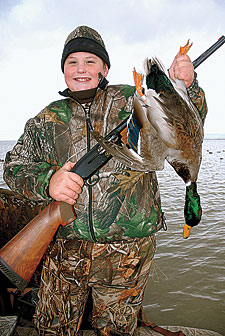 Jake, the author's youngest son, proudly shows off an open-water mallard. |
It's in these featureless open waters that mallards find refuge from hunting pressure. Those who target these birds in open water are writing a new chapter in the puddle duck hunting manual.
Hiding in Plain Sight
The open-water mallard hunter is faced with the challenge of hiding in plain sight. Often these hunters do not have the luxury of slipping into a conveniently located patch of cattails or bulrush, and just as often their stake blind is positioned, or their boat/blind is anchored to the bottom, in the middle of nowhere. With nothing but water in every direction, the question becomes: How can mallards be lured in close enough for quality shooting?
Common sense suggests that mallards would avoid anything on the water, but in practice this is not the case. Mallards will decoy to obvious blinds, so long as the hunters and dogs inside are absolutely motionless. Overhead cover is a critical mallard hunting tactic, as incoming mallards are certain to be high enough to easily look down and survey the situation.
Setting up the decoy spread so incoming birds can land into the wind but crossing out in front of the blind is critical. It's very difficult to convince mallards to land looking directly at the blind.
Not unlike diver hunting, a crossing wind is the perfect setup for luring open-water mallards into gun range. This way, as mallards are pitching into the decoy spread, their attention is focused into open water and away from the nearby blind.
Separating the blind from the decoys also helps give incoming birds a sense of security. At a minimum, there should be 10 yards of open water space between the blind and the first decoys while hunting open water mallards. Setting most of the decoys upwind of the blind also encourages birds to sit down at the back end of the spread and right in front of the blind.
A number of commercial flip-top style blinds are well suited for converting just about any small boat into a mallard-hunting machine. Most of these blinds are built using a frame of aluminum or steel tubing with various kinds of natural or synthetic covering materials attached. The critical aspect is to ensure birds approaching from above can't look down and spot hunters or dogs inside the boat.
The creative among us tend to build our own open-water blinds and boat/blinds, using a wealth of options. The ideal boat/blind takes into consideration the need to conceal hunters and dogs, provide comfort for long hours on the water and meet the special needs of retrievers that must have clear vision outside the blind to effectively mark down fallen birds.
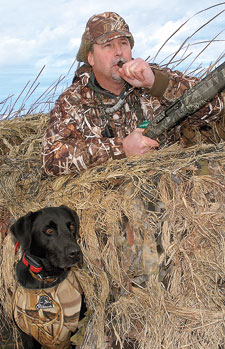 Since retrieves are routinely long, a dog's best hope of marking down birds is to have the same sight picture as the hunter. |
Tungsten Kills
The very nature of hunting mallards in open water calls for longer shooting than is common in marsh hunting. In addition, a crippled bird in open water is far more difficult to retrieve than one wounded in a marsh environmen
t.
Tungsten, bismuth and other premium, high-density waterfowl loads are worth every penny when hunting tough mallards in open water. These loads tend to kill ducks cleanly on average 10-20 yards farther than steel shot, and much farther in some cases.
Hard shot types, including Hevi-Shot, Remington Wingmaster and Winchester Extended Range Waterfowl, tend to pattern very tightly out to 40 yards and beyond in modest chokes such as improved cylinder. Softer shot types, including bismuth and Kent Impact loads, pattern best in a modified or improved modified choke when shooting out to 40 yards and beyond.
More often than not, a crippled duck shot with steel shot will require several more shots on the water to dispatch the mallard. Using high-density premium waterfowl loads eliminates most crippling issues while hunting open water mallards. Also, should a bird be crippled with a premium load, chances are a single follow-up shot on the water will end the drama. In the end, shooting premium loads saves money and the anxiety of losing crippled birds.
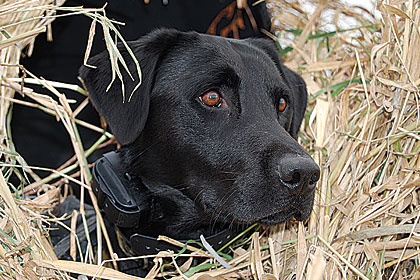 Creating a small hole so the retriever has a clear field of view to falling birds is a must for open-water hunting. |
An Eye-Up For Dogs
No matter how good a hunting dog might be at retrieving, a marked retrieve is easier to accomplish than a blind retrieve while hunting open water mallards. Make every effort to set up your blind or boat so your retriever can watch as the birds approach and mark down birds easily.
A small slit or hole in the blind covering facing the direction of the decoys is all it takes to put your dog in the rock-and-roll position. Some hunters provide their dog a peephole to watch from and a different exit for retrieving. So long as the dog has the same field of view to falling birds as the hunters, the task of picking up dead and crippled birds will be easier.
Buoyancy Matters
Many waterfowl hunters employ neoprene vests for their dogs to protect them from cold water and harsh hunting conditions. As useful as these vests are in keeping a dog warm, they are even more useful in terms of the buoyancy they provide. Buoyant vests allow dogs to ride higher in the water, helping them swim faster and, more importantly, allowing them to have a better view of the water in front of them.
Some vests even come with extra buoyancy, and for the dog hunting in open water mallard environments, this feature is a huge advantage. When hunting in heavy seas and waves, the buoyancy issue can be a matter of life and death for the retriever.
Without a buoyant vest, a hunting dog in open water is risking drowning with every retrieve. This goes double for those strong-willed dogs that refuse to quit when chasing a cripple.
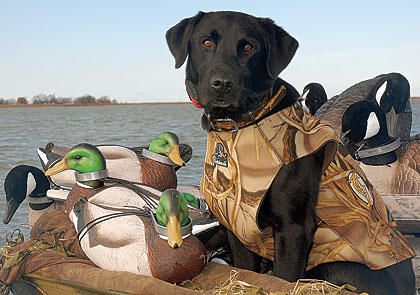 Neoprene vests are a huge asset for the open-water retrieving dog. Some of these vests are manufactured with extra foam filling to help the dog ride higher in the water and maintain a better view of downed birds. Also, extra flotation provides more safety and enables the dog to swim effectively even in rough water. |
Practice and Conditioning
Open-water hunting and long retrieves go hand in hand. The best way to ensure a retrieving dog finds success in this environment is to ascertain the dog is well conditioned physically. Swimming is the perfect conditioning tool, and lots of time in the water also allows the dog to become comfortable making longer-than-normal retrieves.


READ: Tips For Keeping Your Hunting Dog In Shape


Only after a dog is in good physical condition can a hunter attempt to train for mega marks that often require 200-yard or longer retrieves. A 100-yard mark is on the short side for an open water hunt. Even a bird knocked down at the edge of the decoys may sail 40 yards before hitting the water. By the time the dog hits the water and approaches the bird, a simple retrieve can easily turn into a mega mark.
Practice doing 100- to 200-yard marks in the off season until the dog can both mark and fetch effectively birds from these distances. Start short and increase the distance until it's obvious the dog can handle marks twice as long as the typical hunter routinely sees.
When possible, practice in wavy conditions so the dog gets used to the frustrations of swimming in rough water. Building some confidence in the off season helps the dog push forward in the tough conditions that will no doubt face him in the fall.
Whistle Training
Open water and mega marks mean that the dog is likely to end up far enough away that the sound of your voice will not be adequate for shouting commands. A training whistle is the only practical way to train dogs for making long-distance fetches and handling requirements.
Most trainers only use two commands from a training whistle. One hard and short blast means "Stop and look my direction." Once the dog stops and turns around, it's focused on his handler. At this point, it's possible to redirect the dog with a hand signal, potentially saving lots of needless swimming and giving the dog every chance at making a successful retrieve.


READ: Whistle Training
Tactics


The second whistle command is a rapid series of short blasts that mean "here" or "come." This useful command can be used to call a dog off a crippled bird it obviously can't catch. The "come" whistle also allows the handler to pull the dog back toward the blind should the dog overshoot the bird. This happens often with crippled birds that dive and then pop up between the dog and the blind.
Go Get Him
In open water, a retrieving dog is going to experience fetches that are next to impossible. If the dog ends up far from the boat or blind and confused, don't hesitate to get the dog as quickly as possible. Any time the dog gets more than 200 yards away from the blind, it's time to crank up the outboard and head out to pick up the dog.
No bird is worth risking a dog's life. Long retrieves are part of the equation in open-water hunting, but you should be able to distinguish between a tough retrieve and an impossible one.
Summing It Up
The pursuit of mallards in open water requires unique hunting skills and challenges for man and dog alike. Targeting birds outside the normal hides found in traditional marshes means the average bird is going to be harvested 10 to 20 yards farther than when marsh hunting. That means dogs will see some long marks and even longer retrieves.
Enjoying a successful mallard hunt in open water is about hiding in plain sight, keeping the birds' focus off the blind and making sure the dog has a clear field of view to every downed bird. Cover those bases and the science of open-water mallard hunting is an open book.






